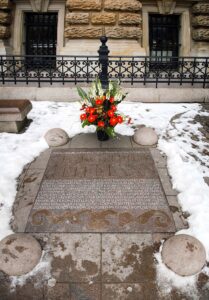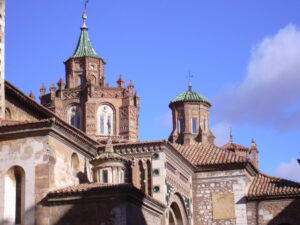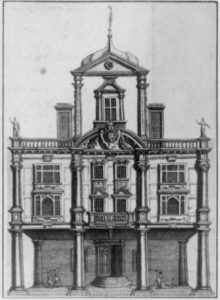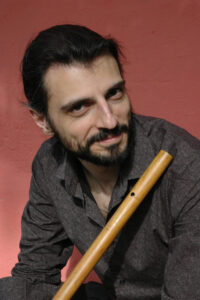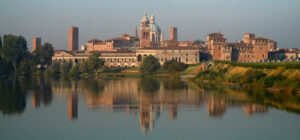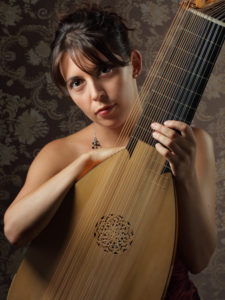Fantazje dla szczęśliwych mieszczan
Trochę zwolniliśmy w ten świąteczny czas, proponuję więc, by w oczekiwaniu na kolejne recenzje wrócić pamięcią do niedawnego festiwalu Actus Humanus Nativitas. A ściślej do koncertu w Ratuszu Głównego Miasta, gdzie Marta Korbel grała Fantazje na skrzypce solo Telemanna. Do zobaczenia w Nowym Roku: oby okazał się równie intensywny i ciekawy – w najlepszym znaczeniu obu słów – jak ten, który właśnie dobiega końca.
***
„Wydaje się, że muzyka tu właśnie ma swoją ojczyznę, w mieście, gdzie najzacniejsi i najbardziej szanowani ludzie skłaniają uwagę ku tej sztuce, gdzie w najznamienitszych rodach przychodzą na świat prawdziwi wirtuozi, gdzie wielu zdolnych adeptów rzemiosła chciałoby zamieszkać stałe”, pisał Georg Philipp Telemann w roku 1728, siedem lat po przyjeździe do Hamburga, Miasta Wolnego i Hanzeatyckiego, które wchodziło wówczas w epokę niezwykle dynamicznego rozwoju. W 1716 roku rajcy podpisali korzystną umowę handlową z Francuzami. W 1725 otworzył się w mieście Courantbank, oddział założonego ponad stulecie wcześniej Banku Hamburskiego – powołany do życia jako potężne narzędzie przeciwdziałania „psuciu” pieniądza kruszcowego, czyli zmniejszania ciężaru monety i obniżania zawartości metali szlachetnych w stopie. W roku 1731 ukazało się pierwsze wydanie „Hamburgische Correspondent”, jednej z najważniejszych i najbardziej wpływowych gazet w ówczesnej Europie. W roku 1736 hamburska Izba Handlowa zaczęła regularnie publikować cotygodniowe raporty „Preiscourant der Wahren in Partheyen” – z oficjalnymi cenami towarów oferowanych na tutejszej giełdzie.
Giełda i ratusz w Hamburgu na obrazie Eliasa Galliego, ok 1680. Ze zbiorów Museum für Hamburgische Geschichte
Telemann dotarł do miasta przy ujściu Łaby w punkcie zwrotnym życia osobistego. Jego żona, Maria Catharina Textor, po urodzeniu dziewiątego dziecka wpadła w depresję, uzależniła się od hazardu i coraz bardziej ryzykownych romansów. Żeby utrzymać liczną rodzinę i spłacić żoninych wierzycieli, Telemann rzucił się w opętańczy wir pracy. W 1721 roku objął posadę kantora i dyrektora muzycznego w Johanneum, najstarszym i najbardziej prestiżowym gimnazjum w Hamburgu, które piastował aż do śmierci w roku 1767, przez ponad pół wieku. Tym samym odpowiadał za jakość muzyki oraz wykonań w pięciu najważniejszych kościołach miasta. W 1722 roku stanął u steru Oper am Gänsemarkt – pierwszego publicznego teatru operowego w Niemczech, otwartego w 1678 roku, niewiele ponad czterdzieści lat po inauguracji weneckiego Teatro San Cassiano. Kierował nim przez szesnaście lat, aż do ostatecznego zamknięcia w roku 1738, i zdążył przez ten czas przyćmić sławę samego Reinharda Keisera, obwołanego kiedyś najwybitniejszym z kompozytorów niemieckiej opery barokowej.
Działał jako wydawca (między innymi dwutygodnika muzycznego „Der getreue Music-Meister”) i organizator pionierskich koncertów publicznych w Niemczech, przede wszystkim w Saal des Zuchthauses, w Baumhaus am Hafen i w Drillhaus der Bürgerwache. Mimo że w chwili przyjazdu do miasta liczył sobie już lat czterdzieści i cieszył się zasłużoną sławą jednego z ważniejszych twórców epoki, jego gwiazda zajaśniała prawdziwym blaskiem dopiero w Hamburgu, dla którego skomponował prawie trzydzieści oper i lwią część pozostałej spuścizny, zamykającej się w liczbie przeszło trzech i pół tysiąca utworów i obejmującej między innymi półtorej setki utworów klawiszowych, kilkadziesiąt kwartetów smyczkowych, ponad sto triów oraz blisko dziewięćdziesiąt kompozycji solowych i prawie drugie tyle na rozmaite instrumenty solowe „senza basso”.
Autograf Telemanna
Nikt bardziej nie zasłużył na miano wizjonera, który uczynił z Hamburga jeden z najprężniejszych ośrodków muzycznych ówczesnej Europy, niż Georg Philipp Telemann. Do jego chwały przyczynił się również zbiór dwunastu intymnych, przeznaczonych zapewne do muzykowania w domu Fantazji na skrzypce solo, a właściwie „violino senza basso”, TWV 4040:14–25 – wydanych w 1735 roku i porównywanych często z odrobinę wcześniejszym cyklem 12 fantaisies à traversière sans basse. Tym, co ewidentnie łączy obydwa cykle, jest umiejętność kształtowania skomplikowanych linii melodycznych, poparta idealnym wyczuciem idiomu poszczególnych instrumentów (Telemann był biegłym wirtuozem zarówno fletu, jak i skrzypiec). Dzieli je zamysł całości – o ile fantazje fletowe zostały pieczołowicie ułożone według następstwa tonacji, zgodnie z teorią afektów, popartą też schematem rytmicznym i wyborem tempa poszczególnych części, o tyle ich skrzypcowy odpowiednik sprawia raczej wrażenie dwóch połączonych ze sobą cyklów. Wskazuje na to zarówno opis samego kompozytora, który przedstawił zawartość zbioru jako sześć fantazji z fugą i sześć „galanterii” (termin oznaczał wówczas modne tańce lub utwory charakterystyczne), jak i nawiązanie do otwierającego całość Largo z pierwszej fantazji B-dur w początkowym Dolce z siódmej fantazji Es-dur.
Niewykluczone, że Telemann zabrał się do pisania fantazji na skrzypce „senza basso” pod wpływem solowych partit i sonat Bacha. W epoce baroku skrzypce traktowano generalnie jako instrument melodyczny, wymagający towarzyszenia continuo dla dopełnienia struktury harmonicznej utworu. Na instrumentach smyczkowych nie da się zagrać „prawdziwych” akordów: dotyczy to także skrzypiec barokowych, wyposażonych wprawdzie w mniej wypukły podstawek, wciąż jednak niepozwalający wydobyć z nich trzech dźwięków naraz. Telemann uciekał się zatem często do style brisé, faktury „łamanej”, we Francji określanej pierwotnie mianem style luthé, jako że wirtuozi instrumentów klawiszowych i violi da gamba nawiązywali do technik stosowanych przez XVII-wiecznych lutnistów. Polegały one nie tylko na arpeggiowaniu akordów, lecz także – między innymi – na zmianach pozycji w obrębie pojedynczej linii melodycznej. Wszystkie te triki przemawiały wprost do wyobraźni słuchacza, zmuszając go do myślowej rekonstrukcji „brakujących” głosów. W fantazjach na skrzypce Telemann tworzył iluzję harmonicznej głębi na podobnej zasadzie, na jakiej malarze kształtowali przestrzeń w obrazie, umiejętnie odwzorowując przedmioty trójwymiarowe na dwuwymiarowej płaszczyźnie. Nie stosował też kontrapunktu tak ściśle, jak przed nim czynił to Bach, oddając prymat linii melodycznej i przeplatając fragmenty fugowane wirtuozowskimi, pełnymi ekspresji popisami w stylu galant.
Tablica pamiątkowa kompozytora przy hamburskim ratuszu. Fot. Klaus Friese
Telemann w pełni wykorzystał potencjał kosmopolitycznego Hamburga. Fantazje z jego zbioru wzbudzają skojarzenia już to z uwerturą francuską, już to z włoskim koncertem, a nawet sonatą kościelną. Dziewiąta fantazja h-moll jest właściwie suitą taneczną, ujętą w rytmy sicilienne, bourée oraz gigue. Pod pewnymi względami XII fantasie per il violino senza basso są w jego twórczości dziełem przełomowym: właściwą im klarowność struktury formalnej, abstrakcyjną nieuchwytność faktury i zuchwałe kontrasty trybów dur-moll można bez przesady uznać za jedne z najwcześniejszych i najbardziej wyrafinowanych zapowiedzi muzycznego klasycyzmu.
A mimo to, wbrew powszechnemu mniemaniu, spuścizna Telemanna popadła w zapomnienie dużo wcześniej, dużo głębiej i na znacznie dłużej niż twórczość młodszego, niemniej „staroświeckiego” Bacha. Lekceważona i pomijana w encyklopediach jeszcze na początku XX stulecia, doczekała się sprawiedliwej oceny niespełna pół wieku temu. Ciekawe, jak zareagowałby Albert Schweitzer, gdyby dożył odkrycia, że część utworów, które podawał za przykład bezwzględnej wyższości Lipskiego Kantora nad kantorem hamburskim, w istocie wyszła spod pióra Telemanna…



